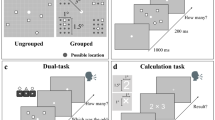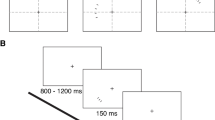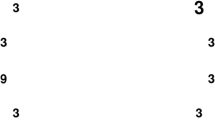Abstract
Dot comparison tasks are commonly used to index an individual’s Approximate Number System (ANS) acuity, but the cognitive processes involved in completing these tasks are poorly understood. Here, we investigated how factors including numerosity ratio, set size and visual cues influence task performance. Forty-four children aged 7–9 years completed a dot comparison task with a range of to-be-compared numerosities. We found that as the size of the numerosities increased, with ratios held constant, accuracy decreased due to the heightened salience of incongruent visual information. Furthermore, in trials with larger numerosities participants’ accuracies were influenced more by the convex hull of the array than the average dot size. The numerosity ratio between the arrays in each trial was an important predictor for all set sizes. We argue that these findings are consistent with a ‘competing processes’ inhibition-based account, where accuracy scores are influenced by individual differences in both ANS acuity and inhibitory control skills.




Similar content being viewed by others
Notes
The same pattern of results were found when these participants were included. However, because we were not certain that these participants understood the task instructions we chose to exclude them.
References
Banks, J., & Oldfield, Z. (2007). Understanding pensions: Cognitive function, numerical ability and retirement saving. Fiscal Studies, 28(2), 143–170.
Barbaresi, W. J., Katusic, S. K., Colligan, R. C., Weaver, A. L., & Jacobsen, S. J. (2005). Math learning disorder: Incidence in a population-based birth cohort, 1976–82, Rochester, Minn. Ambulatory Pediatrics, 5(5), 281–289.
Baroody, A. J. (2003). The development of adaptive expertise and flexibility: The integration of conceptual and procedural knowledge. In A. J. Baroody & A. Dowker (Eds.), The development of arithmetic concepts and skills: Constructing adaptive expertise studies (pp. 1–33). Mahwah: Lawrence Erlbaum Associates Inc.
Barth, H., Beckmann, L., & Spelke, E. S. (2008). Nonsymbolic, approximate arithmetic in children: Abstract addition prior to instruction. Developmental Psychology, 44(5), 1466–1477.
Barth, H., Kanwisher, N., & Spelke, E. S. (2002). The construction of large number representations in adults. Cognition, 86, 201–221.
Barth, H., La Mont, K., Lipton, J., Dehaene, S., Kanwisher, N., & Spelke, E. (2006). Nonsymbolic arithmetic in adults and young children. Cognition, 98, 199–222.
Barth, H., La Mont, K., Lipton, J., & Spelke, E. S. (2005). Abstract number and arithmetic in preschool children. Proceedings of the National Academy of Sciences of the United States of America, 102, 14116–14121.
Blair, C., & Razza, R. P. (2007). Relating effortful control, executive function, and false belief understanding to emerging math and literacy ability in kindergarten. Child Development, 78(2), 647–663.
Bull, R., Espy, K. A., & Wiebe, S. A. (2008). Short-term memory, working memory, and executive functioning in preschoolers: Longitudinal predictors of mathematical achievement at age 7 years. Developmental Neuropsychology, 33(3), 205–228.
Bull, R., & Scerif, G. (2001). Executive functioning as a predictor of children’s mathematics ability: Inhibition, switching and working memory. Developmental Neuropsychology, 19(3), 273–293.
Cappelletti, M., Didino, D., Stoianov, I., & Zorzi, M. (2014). Number skills are maintained in healthy ageing. Cognitive Psychology, 69, 25–45.
Chen, Q., & Li, J. (2014). Association between individual differences in non-symbolic number acuity and math performance: A meta-analysis. Acta Psychologica, 148, 163–172.
De Smedt, B., Noël, M.-P., Gilmore, C., & Ansari, D. (2013). How do symbolic and non-symbolic numerical magnitude processing skills relate to individual differences in children’s mathematical skills? A review of evidence from brain and behavior. Trends in Neuroscience and Education, 2, 48–55.
Dehaene, S. (1997). The number sense. Oxford: Oxford University Press.
Dempster, F. N. (1992). The rise and fall of the inhibitory mechanism: Toward a unified theory of cognitive development and aging. Developmental Review, 12(1), 45–75.
DeWind, N. K., & Brannon, E. M. (2012). Malleability of the approximate number system: Effects of feedback and training. Frontiers in Human Neuroscience, 6(68), 1–10.
Emmerton, J. (1998). Numerosity differences and effects of stimulus density on pigeons’ discrimination performance. Animal Learning & Behavior, 26(3), 243–256.
Espy, K. A., McDiarmid, M. M., Cwik, M. F., Stalets, M. M., Hamby, A., & Senn, T. E. (2004). The contribution of executive functions to emergent mathematic skills in preschool children. Developmental Neuropsychology, 26(1), 465–486.
Feigenson, L., Libertus, M. E., & Halberda, J. (2013). Links Between the Intuitive Sense of Number and Formal Mathematics Ability. Child Development Perspectives, 7(2), 74–79.
Friso-van den Bos, I., van der Ven, S. H. G., Kroesbergen, E. H., & van Luit, J. E. H. (2013). Working memory and mathematics in primary school children: A meta-analysis. Educational Research Review, 10, 29–44.
Fuhs, M. W., & McNeil, N. M. (2013). ANS acuity and mathematics ability in preschoolers from low-income homes: contributions of inhibitory control. Developmental Science, 16, 136–148.
Gebuis, T., & Gevers, W. (2011). Numerosities and space; indeed a cognitive illusion! A reply to de Hevia and Spelke (2009). Cognition, 121(2), 248–252.
Gebuis, T., Kadosh, R. C., de Haan, E., & Henik, A. (2009). Automatic quantity processing in 5-year olds and adults. Cognitive Processing, 10(2), 133–142.
Gebuis, T., & Reynvoet, B. (2011). Generating nonsymbolic number stimuli. Behavior Research Methods, 43, 981–986.
Gebuis, T., & Reynvoet, B. (2012a). The interplay between nonsymbolic number and its continuous visual properties. Journal of Experimental Psychology: General, 141(4), 642–648.
Gebuis, T., & Reynvoet, B. (2012b). The role of visual information in numerosity estimation. PLoS ONE, 7(5), e37426.
Gebuis, T., & van der Smagt, M. J. (2011). False approximations of the approximate number system. PLoS ONE, 6(10), e25405.
Gerardi, K., Goette, L., & Meier, S. (2013). Numerical ability predicts mortgage default. Proceedings of the National Academy of Sciences, 110(28), 11267–11271.
Gifford, S., & Rockliffe, F. (2012). Mathematics difficulties: Does one approach fit all? Research in Mathematics Education, 14(1), 1–15.
Gilmore, C., Attridge, N., Clayton, S., Cragg, L., Johnson, S., Marlow, N., & Inglis, M. (2013). Individual differences in inhibitory control, not non-verbal number acuity, correlate with mathematics achievement. PLoS ONE, 8(6), e67374.
Halberda, J., Ly, R., Wilmer, J. B., Naiman, D. Q., & Germine, L. (2012). Number sense across the lifespan as revealed by a massive Internet-based sample. Proceedings of the National Academy of Sciences, 109(28), 11116–11120.
Halberda, J., Mazzocco, M. M., & Feigenson, L. (2008). Individual differences in non-verbal number acuity correlate with maths achievement. Nature, 455(7213), 665–668.
Hauser, M. D., Tsao, F., Garcia, P., & Spelke, E. S. (2003). Evolutionary foundations of number: Spontaneous representation of numerical magnitudes by cotton—top tamarins. Proceedings of the Royal Society of London. Series B: Biological Sciences, 270(1523), 1441–1446.
Holloway, I. D., & Ansari, D. (2009). Mapping numerical magnitudes onto symbols: The numerical distance effect and individual differences in children’s mathematics achievement. Journal of Experimental Child Psychology, 103(1), 17–29.
Hurewitz, F., Gelman, R., & Schnitzer, B. (2006). Sometimes area counts more than number. Proceedings of the National Academy of Sciences, 103(51), 19599–19604.
Hyde, D. C., Khanum, S., & Spelke, E. S. (2014). Brief non-symbolic, approximate number practice enhances subsequent exact symbolic arithmetic in children. Cognition, 131(1), 92–107.
Inglis, M., Attridge, N., Batchelor, S., & Gilmore, C. (2011). Non-verbal number acuity correlates with symbolic mathematics achievement: But only in children. Psychonomic Bulletin & Review, 18(6), 1222–1229.
Inglis, M., & Gilmore, C. (2013). Sampling from the mental number line: How are Approximate Number System representations formed? Cognition, 129, 63–69.
Inglis, M., & Gilmore, C. (2014). Indexing the Approximate Number System. Acta Psychologica, 145, 147–155.
Jordan, N. C., Hanich, L. B., & Kaplan, D. (2003). A longitudinal study of mathematical competencies in children with specific mathematics difficulties versus children with comorbid mathematics and reading difficulties. Child Development, 74(3), 834–850.
LeFevre, J. A., Fast, L., Skwarchuk, S. L., Smith Chant, B. L., Bisanz, J., Kamawar, D., & Penner Wilger, M. (2010). Pathways to mathematics: Longitudinal predictors of performance. Child Development, 81(6), 1753–1767.
Libertus, M. E., Feigenson, L., & Halberda, J. (2011). Preschool acuity of the approximate number system correlates with school math ability. Developmental Science, 14, 1292–1300.
Libertus, M. E., Odic, D., & Halberda, J. (2012). Intuitive sense of number correlates with math scores on college-entrance examination. Acta Psychologica, 141(3), 373–379.
MacLeod, C. M. (1991). Half a century of research on the Stroop effect: An integrative review. Psychological Bulletin, 109(2), 163–203.
Mazzocco, M. M. M., Feigenson, L., & Halberda, J. (2011). Preschoolers’ precision of the approximate number system predicts later school mathematics performance. PLoS ONE, 6(9), e23749.
Nigg, J. T. (2000). On inhibition/disinhibition in developmental psychopathology: Views from cognitive and personality psychology and a working inhibition taxonomy. Psychological Bulletin, 126(2), 220.
Nys, J., & Content, A. (2012). Judgement of discrete and continuous quantity in adults: Number counts! The Quarterly Journal of Experimental Psychology, 65(4), 675–690.
Odic, D., Hock, H., & Halberda, J. (2013a). Hysteresis affects number discrimination in young children. Journal of Experimental Psychology: General, 143(1), 255–265.
Odic, D., Libertus, M., Feigenson, L., & Halberda, J. (2013b). Developmental change in the acuity of approximating area and approximating number. Developmental Psychology, 49, 1103–1112.
Park, J., & Brannon, E. M. (2013). The approximate number system improves math proficiency. Psychological Science, 24(10), 2013–2019.
Piazza, M., Facoetti, A., Trussardi, A. N., Berteletti, I., Conte, S., Lucangeli, D., & Zorzi, M. (2010). Developmental trajectory of number acuity reveals a severe impairment in developmental dyscalculia. Cognition, 116, 33–41.
Piazza, M., Pica, P., Izard, V., Spelke, E. S., & Dehaene, S. (2013). Education enhances the acuity of the nonverbal Approximate Number System. Psychological Science, 24, 1037–1043.
Pica, P., Lemer, C., Izard, V., & Dehaene, S. (2004). Exact and approximate arithmetic in an Amazonian indigene group. Science, 306(5695), 499–503.
Price, G. R., Palmer, D., Battista, C., & Ansari, D. (2012). Nonsymbolic numerical magnitude comparison: Reliability and validity of different task variants and outcome measures, and their relationship to arithmetic achievement in adults. Acta Psychologica, 140(1), 50–57.
Revkin, S. K., Piazza, M., Izard, V., Cohen, L., & Dehaene, S. (2008). Does subitizing reflect numerical estimation? Psychological Science, 19(6), 607–614.
St Clair-Thomson, H. L., & Gathercole, S. E. (2006). Executive functions and achievement in school: Shifting, updating, inhibition, and working memory. The Quarterly Journal of Experimental Psychology, 59(4), 745–759.
Stavy, R., & Babai, R. (2010). Overcoming intuitive interference in mathematics: Insights from behavioral, brain imaging and intervention studies. ZDM, 42(6), 621–633.
Stroop, J. R. (1935). Studies of interference in serial verbal reactions. Journal of Experimental Psychology: General, 18(6), 643–662.
Szűcs, D., Nobes, A., Devine, A., Gabriel, F., Gebuis, T. (2013). Visual stimulus parameters seriously compromise the measurement of Approximate Number System acuity and comparative effects between adults and children. Frontiers in Psychology, 4, 444. doi:10.3389/fpsyg.2013.00444
Xu, F., & Spelke, E. S. (2000). Large number discrimination in 6-month-old infants. Cognition, 74(1), B1–B11.
Author information
Authors and Affiliations
Corresponding author
Additional information
This research was supported by a Royal Society Dorothy Hodgkin Fellowship.
Rights and permissions
About this article
Cite this article
Clayton, S., Gilmore, C. Inhibition in dot comparison tasks. ZDM Mathematics Education 47, 759–770 (2015). https://doi.org/10.1007/s11858-014-0655-2
Accepted:
Published:
Issue Date:
DOI: https://doi.org/10.1007/s11858-014-0655-2




